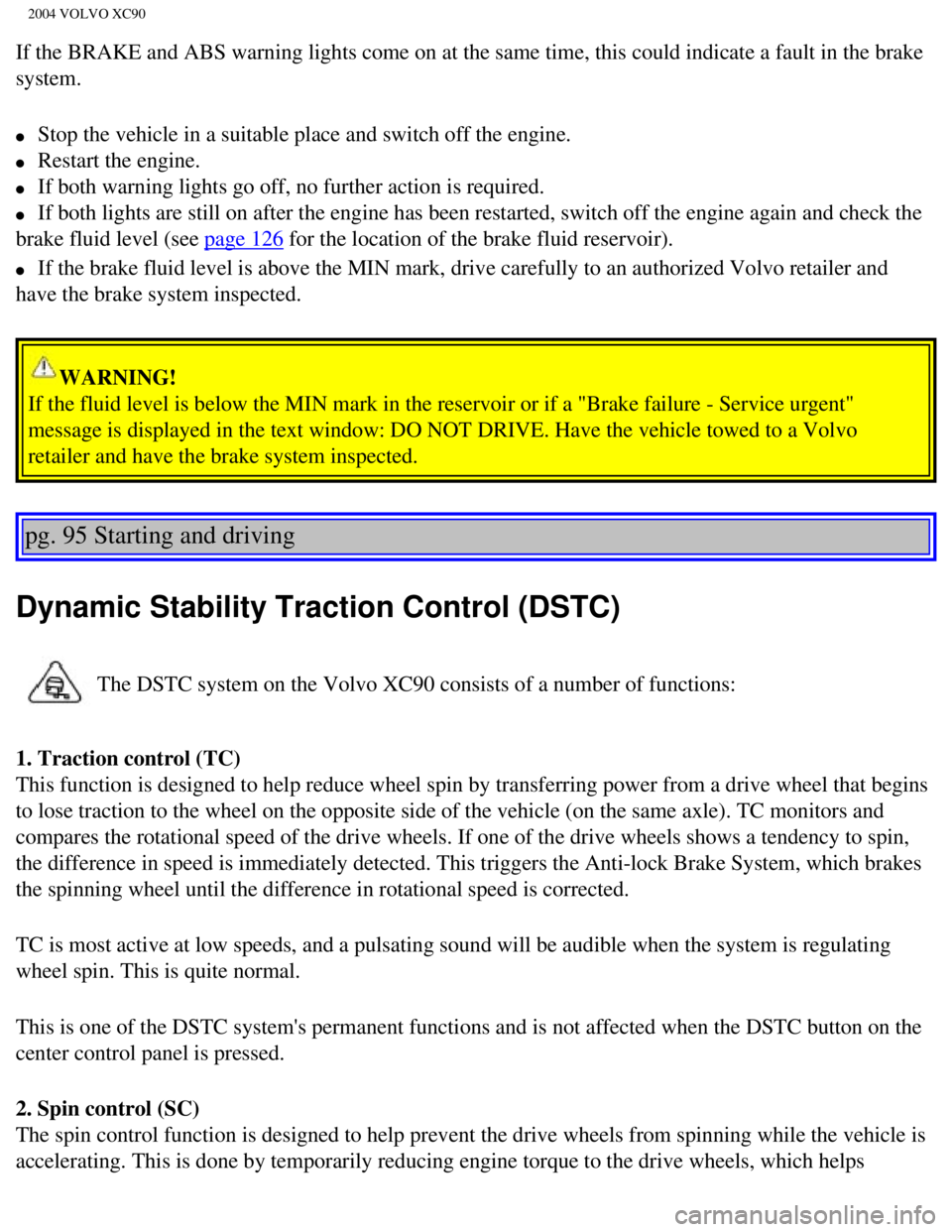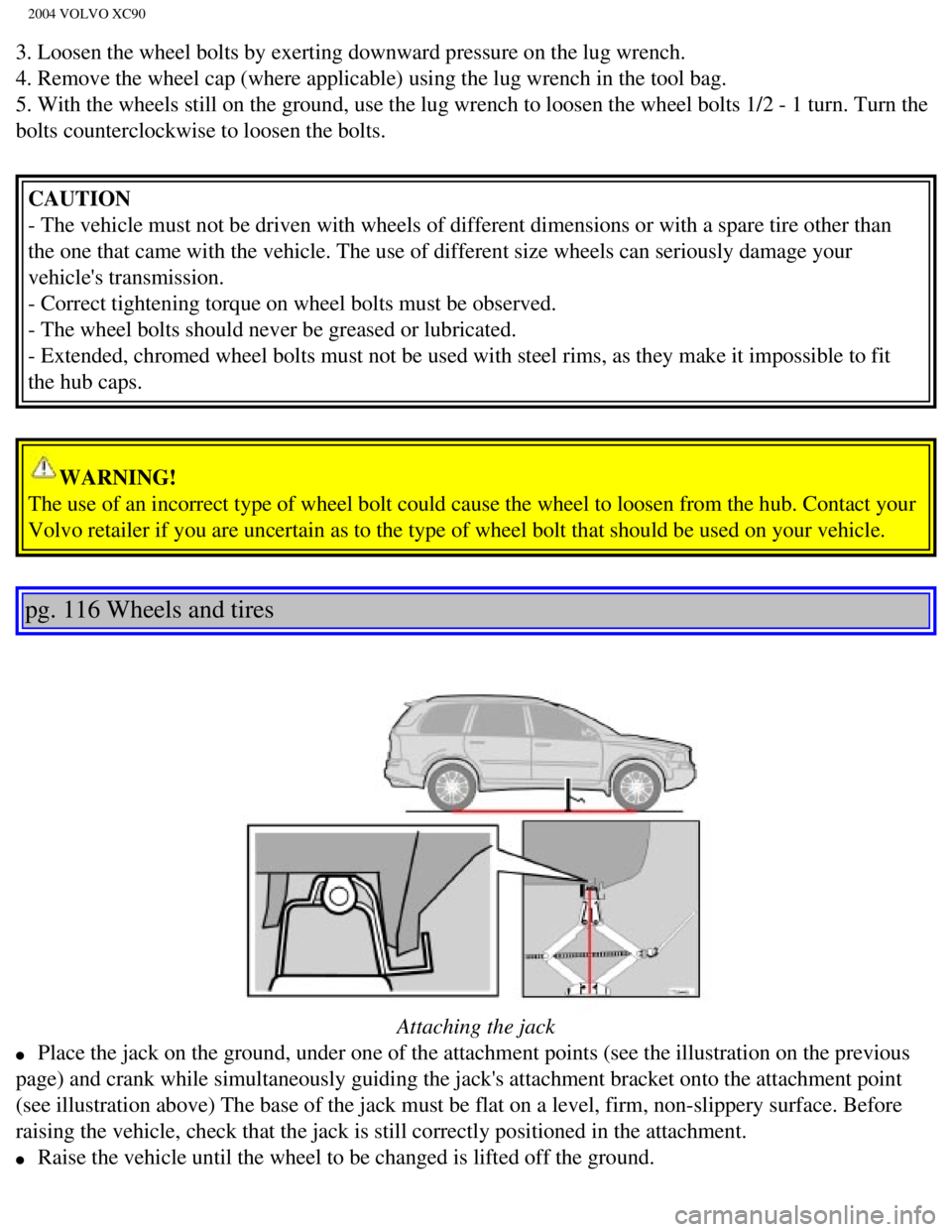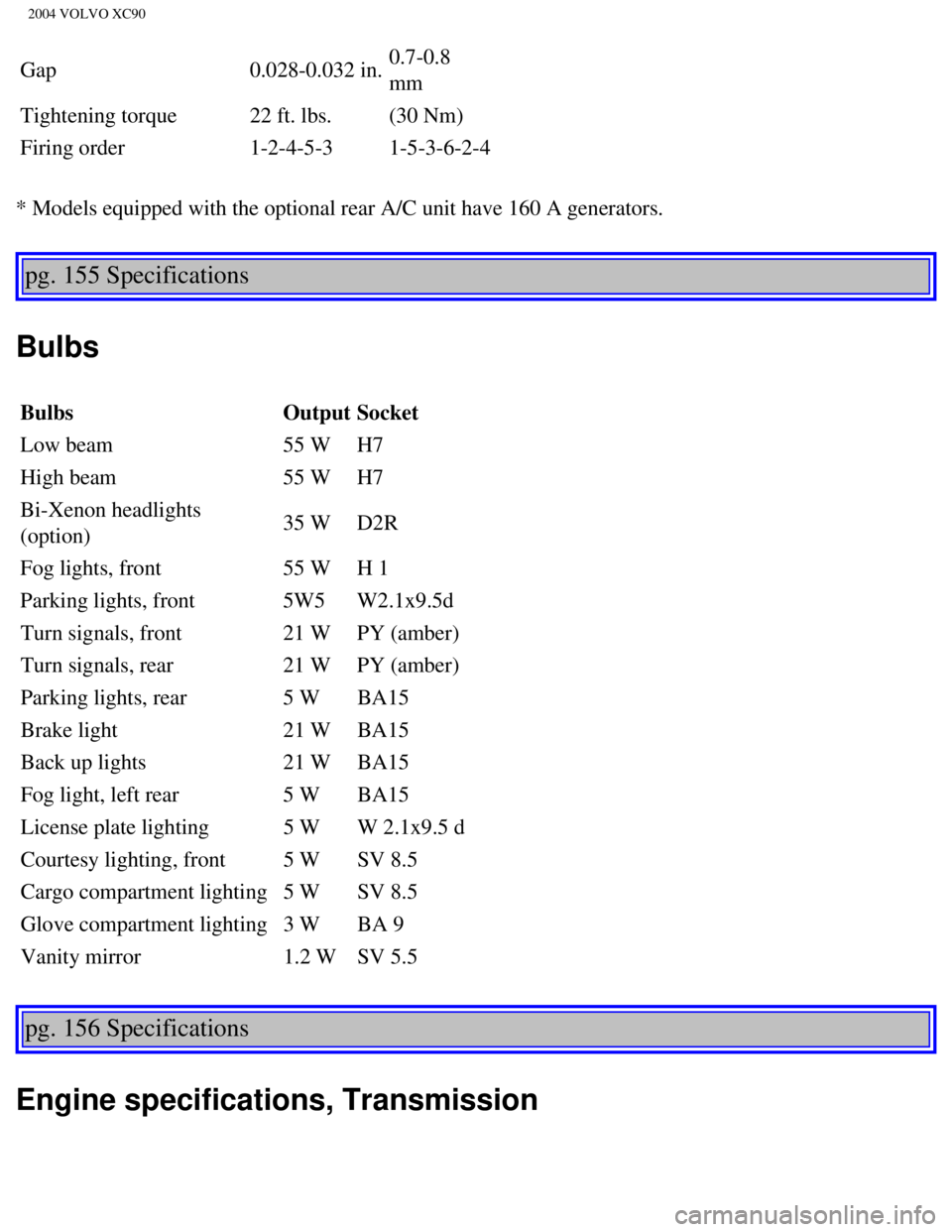torque VOLVO XC90 2004 Owners Manual
[x] Cancel search | Manufacturer: VOLVO, Model Year: 2004, Model line: XC90, Model: VOLVO XC90 2004Pages: 245, PDF Size: 6.36 MB
Page 124 of 245

2004 VOLVO XC90
If the BRAKE and ABS warning lights come on at the same time, this could\
indicate a fault in the brake
system.
l Stop the vehicle in a suitable place and switch off the engine.
l Restart the engine.
l If both warning lights go off, no further action is required.
l If both lights are still on after the engine has been restarted, switch \
off the engine again and check the
brake fluid level (see
page 126 for the location of the brake fluid reservoir).
l If the brake fluid level is above the MIN mark, drive carefully to an au\
thorized Volvo retailer and
have the brake system inspected.
WARNING!
If the fluid level is below the MIN mark in the reservoir or if a "Brake\
failure - Service urgent"
message is displayed in the text window: DO NOT DRIVE. Have the vehicle \
towed to a Volvo
retailer and have the brake system inspected.
pg. 95 Starting and driving
Dynamic Stability Traction Control (DSTC)
The DSTC system on the Volvo XC90 consists of a number of functions:
1. Traction control (TC)
This function is designed to help reduce wheel spin by transferring powe\
r from a drive wheel that begins
to lose traction to the wheel on the opposite side of the vehicle (on t\
he same axle). TC monitors and
compares the rotational speed of the drive wheels. If one of the drive w\
heels shows a tendency to spin,
the difference in speed is immediately detected. This triggers the Anti-\
lock Brake System, which brakes
the spinning wheel until the difference in rotational speed is corrected\
.
TC is most active at low speeds, and a pulsating sound will be audible w\
hen the system is regulating
wheel spin. This is quite normal.
This is one of the DSTC system's permanent functions and is not affected\
when the DSTC button on the
center control panel is pressed.
2. Spin control (SC)
The spin control function is designed to help prevent the drive wheels f\
rom spinning while the vehicle is
accelerating. This is done by temporarily reducing engine torque to the \
drive wheels, which helps
file:///K|/ownersdocs/2004/2004_XC90/04xc90_06b.htm (3 of 17)12/30/200\
6 4:35:23 PM
Page 136 of 245

2004 VOLVO XC90
Make sure that the load carrier is pressed firmly out against the roof r\
ail. Screw the load carrier in place.
Use the supplied torque wrench and tighten to the mark on the wrench (c\
orresponding to 6 Nm). See
illustration.
Load carrier cover
The vehicle's ignition key or the stud on the edge of the supplied torqu\
e wrench can be used to undo or
tighten the cover. Turn a quarter turn (90 degrees). See illustration.\
pg. 105 Starting and driving
Cold weather precautions
If you wish to check your vehicle before the approach of cold weather, t\
he following advice is worth
noting:
l Make sure that the engine coolant contains 50 percent antifreeze. Any ot\
her mixture will reduce
freeze protection. This gives protection against freezing down to -31°\
F (-35°C). See section "Coolant".
The use of "recycled" antifreeze is not approved by Volvo. Different typ\
es of antifreeze must not
be mixed.
l Volvo recommends using only genuine Volvo antifreeze in your vehicle's r\
adiator. Your Volvo
retailer stocks plenty of Volvo engine coolant to help protect your vehi\
cle during cold weather.
l Try to keep the fuel tank well filled - this prevents the formation of condensation in the tank. \
In
addition, in extremely cold weather conditions it is worthwhile to add f\
uel line de-icer before refueling.
l The viscosity of the engine oil is important. Oil with low viscosity (thinner oil) improves cold-
weather starting as well as decreasing fuel consumption while the engine\
is warming up. For winter use,
5W-30 oil, particularly the synthetic type*, is recommended. Be sure to \
use good quality oil but do not
use cold-weather oil for hard driving or in warm weather. See section "E\
ngine oil" for more information.
l The load placed on the battery is greater during the winter since the windshield wipers, lighting, etc\
.
are used more often. Moreover, the capacity of the battery decreases as \
the temperature drops. In very
cold weather, a poorly charged battery can freeze and be damaged. It is \
therefore advisable to check the
file:///K|/ownersdocs/2004/2004_XC90/04xc90_06b.htm (15 of 17)12/30/20\
06 4:35:23 PM
Page 155 of 245

2004 VOLVO XC90
3. Loosen the wheel bolts by exerting downward pressure on the lug wrenc\
h.
4. Remove the wheel cap (where applicable) using the lug wrench in the\
tool bag.
5. With the wheels still on the ground, use the lug wrench to loosen the\
wheel bolts 1/2 - 1 turn. Turn the
bolts counterclockwise to loosen the bolts. CAUTION
- The vehicle must not be driven with wheels of different dimensions or \
with a spare tire other than
the one that came with the vehicle. The use of different size wheels can\
seriously damage your
vehicle's transmission.
- Correct tightening torque on wheel bolts must be observed.
- The wheel bolts should never be greased or lubricated.
- Extended, chromed wheel bolts must not be used with steel rims, as the\
y make it impossible to fit
the hub caps.
WARNING!
The use of an incorrect type of wheel bolt could cause the wheel to loos\
en from the hub. Contact your
Volvo retailer if you are uncertain as to the type of wheel bolt that sh\
ould be used on your vehicle.
pg. 116 Wheels and tires
Attaching the jack
l Place the jack on the ground, under one of the attachment points (see t\
he illustration on the previous
page) and crank while simultaneously guiding the jack's attachment brac\
ket onto the attachment point
(see illustration above) The base of the jack must be flat on a level,\
firm, non-slippery surface. Before
raising the vehicle, check that the jack is still correctly positioned i\
n the attachment.
l Raise the vehicle until the wheel to be changed is lifted off the ground\
.
file:///K|/ownersdocs/2004/2004_XC90/04xc90_08.htm (12 of 13)12/30/200\
6 4:35:25 PM
Page 202 of 245

2004 VOLVO XC90
Gap 0.028-0.032 in.0.7-0.8
mm
Tightening torque 22 ft. lbs. (30 Nm)
Firing order 1-2-4-5-3 1-5-3-6-2-4
* Models equipped with the optional rear A/C unit have 160 A generators.\
pg. 155 Specifications
Bulbs
Bulbs OutputSocket
Low beam 55 W H7
High beam 55 W H7
Bi-Xenon headlights
(option) 35 W
D2R
Fog lights, front 55 W H 1
Parking lights, front 5W5 W2.1x9.5d
Turn signals, front 21 W PY (amber)
Turn signals, rear 21 W PY (amber)
Parking lights, rear 5 W BA15
Brake light 21 W BA15
Back up lights 21 W BA15
Fog light, left rear 5 W BA15
License plate lighting 5 W W 2.1x9.5 d
Courtesy lighting, front 5 W SV 8.5
Cargo compartment lighting 5 W SV 8.5
Glove compartment lighting 3 W BA 9
Vanity mirror 1.2 W SV 5.5
pg. 156 Specifications
Engine specifications, Transmission
file:///K|/ownersdocs/2004/2004_XC90/04xc90_10.htm (9 of 11)12/30/2006\
4:35:29 PM
Page 203 of 245

2004 VOLVO XC90
B5254T2 B6294T
Output (kW/rps) 154/83 200/85
- (hp/rpm) 208/5000 268/5100
Torque (Nm/rps) 320/25-75 380/30-83
- (ft. lbs./rpm) 236/1500-4500 280/1800-5000
No. of cylinders 5 6
Bore (mm) 83 83
Stroke (mm) 93.2 90
Cylinder displacement,
liters 2.52 (153.8 cu
in)
2.92 (178.3 cu in)
Compression ratio 9.0:1 8.5:1
Charge air cooler (Intercooler)
Turbocharged engines employ a turbo-compressor to force air into the eng\
ine inlet manifold and a
charge air cooler to cool the compressed inlet air. The resulting increa\
se in air flow raises pressure in the
intake manifold and increases engine power over that developed by the no\
rmally-aspirated engine. The
charge air cooler (which resembles a radiator) is located between the \
turbo-compressor and inlet
manifold.
Fuel system
The engine is equipped with a multiport fuel injection system.
pg. 157 Specifications
Volvo On Call Roadside Assistance
Your new Volvo comes with a four year ON CALL roadside assistance. Addit\
ional information,
features, and benefits are described in a separate information package i\
n your glove compartment.
If you have misplaced your package, dial:
In the U.S.A.
1-800-638-6586 (1-800-63-VOLVO)
In Canada:
1-800-263-0475
Technician certification
In addition to Volvo factory training, Volvo supports certification by t\
he National Institute for
Automotive Excellence (A.S.E.). Certified technicians have demonstrate\
d a high degree of competence
in specific areas. Besides passing exams, each technician must also have\
worked in the field for two or
more years before a certificate is issued. These professional technician\
s are best able to analyze vehicle
file:///K|/ownersdocs/2004/2004_XC90/04xc90_10.htm (10 of 11)12/30/200\
6 4:35:29 PM